powdered wig

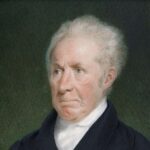 Every era has its trends. And the affluent sector of society is far more likely to go for the odd trends, to prove that they are high society, than the everyday guy. One such trend, that took place in the second half of the 18th century, was the wearing of the wig. It was considered a major status symbol. Nevertheless, by 1800, short, natural hair was all the rage again. That seems to be the problem with trends. Sometimes, they barely get started and suddenly they are over. The trend was toward the wearing of curly white wigs by gentlemen in the 18th century as part of their everyday look. Of course, many people will remember George Washington, with a nod of their head, but the reality is that George Washington never wore a wig. That was his real hair, with the addition of white powder. He, unlike many other men of that era, had a head full of red hair. He powdered it, because will he had plenty of hair to look like a wig, it was red. When Gilbert Stuart, the famous portraitist, painted the Founding Fathers, he depicted five of the first six Presidents with pure white hair. Unlike Washington, the next four Presidents, John Adams, Thomas Jefferson, James Madison and James Monroe did wear wigs, so his depiction of them was correct, and Washington wore his hair in that style, so he could look like he wore a wig without the expense of one.
Every era has its trends. And the affluent sector of society is far more likely to go for the odd trends, to prove that they are high society, than the everyday guy. One such trend, that took place in the second half of the 18th century, was the wearing of the wig. It was considered a major status symbol. Nevertheless, by 1800, short, natural hair was all the rage again. That seems to be the problem with trends. Sometimes, they barely get started and suddenly they are over. The trend was toward the wearing of curly white wigs by gentlemen in the 18th century as part of their everyday look. Of course, many people will remember George Washington, with a nod of their head, but the reality is that George Washington never wore a wig. That was his real hair, with the addition of white powder. He, unlike many other men of that era, had a head full of red hair. He powdered it, because will he had plenty of hair to look like a wig, it was red. When Gilbert Stuart, the famous portraitist, painted the Founding Fathers, he depicted five of the first six Presidents with pure white hair. Unlike Washington, the next four Presidents, John Adams, Thomas Jefferson, James Madison and James Monroe did wear wigs, so his depiction of them was correct, and Washington wore his hair in that style, so he could look like he wore a wig without the expense of one.
Trends weren’t the only reason for the wigs, however. In the 17th century, hairlines were an important aspect of fashion. It was thought that a “well-bred man” would have a good hairline. Unfortunately, in the pre-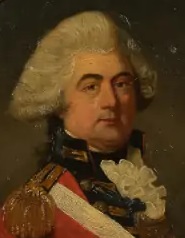 antibiotics world, syphilis was on the rise in Europe. It ultimately affected more Europeans than the Black Plague. Without antibiotics, people afflicted with syphilis suffered all the effects, including sores and patchy hair loss. That became a huge problem for men of status. Because of that, wigs were commonly used to cover up hair loss, and it wasn’t until two Kings started to lose their hair, that their use became widespread. King Louis XIV of France experienced hair loss at the early age of 17, and he hired 48 wigmakers to help combat his thinning locks. His English cousin, King Charles II, began wearing wigs a few years later, when his hair began to grey prematurely. Both conditions were indications of syphilis. A fashion was born, as courtiers started wearing wigs, and the trend trickled down to the merchant class. Of course, as we all know syphilis was not the only reason for balding, nevertheless, it could have been a bad thing to have people assuming.
antibiotics world, syphilis was on the rise in Europe. It ultimately affected more Europeans than the Black Plague. Without antibiotics, people afflicted with syphilis suffered all the effects, including sores and patchy hair loss. That became a huge problem for men of status. Because of that, wigs were commonly used to cover up hair loss, and it wasn’t until two Kings started to lose their hair, that their use became widespread. King Louis XIV of France experienced hair loss at the early age of 17, and he hired 48 wigmakers to help combat his thinning locks. His English cousin, King Charles II, began wearing wigs a few years later, when his hair began to grey prematurely. Both conditions were indications of syphilis. A fashion was born, as courtiers started wearing wigs, and the trend trickled down to the merchant class. Of course, as we all know syphilis was not the only reason for balding, nevertheless, it could have been a bad thing to have people assuming.
The wigs were called perukes. They were convenient because they were relatively easy to maintain, only needing to be sent to a wigmaker for a delousing. I’m sure that the powder, often flour, attracted every kind of bug imaginable. As wigs became more popular, they became a status symbol for people to “flaunt their wealth. An everyday wig cost 25 shillings, a week’s worth of wages for a common Londoner. The term ‘bigwig’ stems from this era, when British nobility would spend upwards of 800 shillings on wigs. In 1700, 800 shillings was approximately £40 (about $50 today) which when calculated for inflation, comes out to around £8,297 or $10,193 in today’s currency.”
Men weren’t the only ones to buy into the trend. Women, like Marie Antoinette were famous for their wigs. Military officers, especially in the British Army, also wore wigs. Some officers wore wigs, but only very specific military plait wigs, not the wigs that were bought and worn by those in high society. According to Revolutionary War Journal, “perukes were hot and heavy, extremely expensive, and constantly infected with bugs,” which was 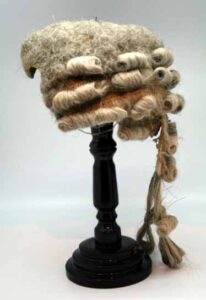
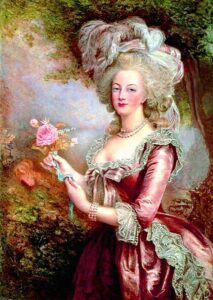 problematic for military use. In 1706, the military officers mostly used Campaign wigs, particularly the Ramillies wig, which was named after a British victory during the War of Spanish Succession. It was a short pigtail, or “queue” tied near the scalp and at the bottom of the plait. While these queues were originally fashioned from a soldier’s real hair, fake queues quickly became the norm. Nevertheless, the wigs were hot and uncomfortable, they were often bug infested, and by 1800, people were over it. That part hasn’t changed much over the years either. As anyone who wore a wig after Chemotherapy can tell you, at some point, most people just embrace the bald, and some men even shave their heads at the first sign of balding. Another was of embracing the bald.
problematic for military use. In 1706, the military officers mostly used Campaign wigs, particularly the Ramillies wig, which was named after a British victory during the War of Spanish Succession. It was a short pigtail, or “queue” tied near the scalp and at the bottom of the plait. While these queues were originally fashioned from a soldier’s real hair, fake queues quickly became the norm. Nevertheless, the wigs were hot and uncomfortable, they were often bug infested, and by 1800, people were over it. That part hasn’t changed much over the years either. As anyone who wore a wig after Chemotherapy can tell you, at some point, most people just embrace the bald, and some men even shave their heads at the first sign of balding. Another was of embracing the bald.
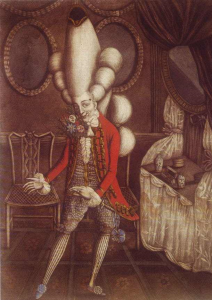 Most people, men anyway, think that it is only women who are fashion conscious to a fault. While many women are very fashion conscious, so are many men, and the fashions that some of the men wore can be just as dangerous. When fashion consists of the wearing of articles of clothing or accessories that have the ability to cause death or injury, we are in danger of sacrificing too much in the name of fashion.
Most people, men anyway, think that it is only women who are fashion conscious to a fault. While many women are very fashion conscious, so are many men, and the fashions that some of the men wore can be just as dangerous. When fashion consists of the wearing of articles of clothing or accessories that have the ability to cause death or injury, we are in danger of sacrificing too much in the name of fashion.
Some fashions do no harm, but looking back on them, we can see just how silly they looked. Nevertheless, powdered wigs were in fashion for men in several different centuries. Long hair was considered a show of status, for both men and women over the years. In ancient Greece, long male hair was a symbol of wealth and power, while a shaven head was appropriate for a slave. The problem occurred when the person, usually the men, but women too, had thinning hair. If their social status depended on that hair, they would need a way to fix the problem when it did not exist. The powdered wig helped with that, and some men wore their wigs in very elaborate styles. In the 1760s, aristocratic British men donned large wigs with a small hat or feather at the top. The young men who took up this fashion trend reportedly brought it back from their “Grand Tour” across Continental Europe in which they intended to “deepen cultural knowledge.” The style is, in fact, named after the Italian pasta dish…macaroni, signifying sophistication and worldliness. It is here that we get the song many of us have wondered about called, “Yankee Doodle,” the lyrics of which pointed out that the feather on top was supposedly called macaroni.
The shoes of the men have taken some strange turns as well. Known as the Poulaine, this super long shoe  reigned supreme with men across Europe in the late 14th century. The shoes, called Crakow were named after Krákow, Poland because they were introduced to England by the Polish nobles. Once the shoes were seen at court, they became all the rage…even though the shoes were six to twenty four inches long. I’m sure you are thinking to yourself, “Who would be crazy enough to wear these?” Well, I’ll tell you that current styles (or maybe just a year or so in the past) saw women, and men too, wearing shoes that had an extra long pointed toe, so it isn’t just an oddity of 14th century Britain. The shoes were a quick indicator of social status…the longer the shoe, the higher the wearer’s station. Some of these shoes were so long that chains were sometimes strung from the toe of the Crakow to the knee to allow the wearer to walk. Other times the toes were stuffed with material for the same reason, making the toes stiff. The strange shoes were considered ridiculous, vain, and dangerous by many conservatives and church leaders, who called them “devil’s fingers.”
reigned supreme with men across Europe in the late 14th century. The shoes, called Crakow were named after Krákow, Poland because they were introduced to England by the Polish nobles. Once the shoes were seen at court, they became all the rage…even though the shoes were six to twenty four inches long. I’m sure you are thinking to yourself, “Who would be crazy enough to wear these?” Well, I’ll tell you that current styles (or maybe just a year or so in the past) saw women, and men too, wearing shoes that had an extra long pointed toe, so it isn’t just an oddity of 14th century Britain. The shoes were a quick indicator of social status…the longer the shoe, the higher the wearer’s station. Some of these shoes were so long that chains were sometimes strung from the toe of the Crakow to the knee to allow the wearer to walk. Other times the toes were stuffed with material for the same reason, making the toes stiff. The strange shoes were considered ridiculous, vain, and dangerous by many conservatives and church leaders, who called them “devil’s fingers.”
In the 19th century, men began wearing detachable collars, that were heavily starched until they were quite stiff. While the collars didn’t look all that odd, they could be deadly. Because they were so heavily starched, taken to the extreme of the collar being nearly unbendable, and because they were attached with a singular or  pair of studs, the collar could slowly asphyxiate a man, if he fell asleep or passed out while drinking. It had a similar effect to a cord being wrapped tightly around the poor man’s neck. Another dangerous aspect of the collar was its pointed corners. A Saint Louis man, wearing one of these collars, tripped in the street and the pointed corners of the collar jabbed into this throat, “making two ugly gashes.” If the gash happened to be in the vicinity of the Jugular vein, death could come quite quickly. These collars were so lethal, in fact, that they were known as “the father killer.” I can only imagine how many women and children pleaded with their husbands or fathers not to wear the collar, which maybe should have been called the choker.
pair of studs, the collar could slowly asphyxiate a man, if he fell asleep or passed out while drinking. It had a similar effect to a cord being wrapped tightly around the poor man’s neck. Another dangerous aspect of the collar was its pointed corners. A Saint Louis man, wearing one of these collars, tripped in the street and the pointed corners of the collar jabbed into this throat, “making two ugly gashes.” If the gash happened to be in the vicinity of the Jugular vein, death could come quite quickly. These collars were so lethal, in fact, that they were known as “the father killer.” I can only imagine how many women and children pleaded with their husbands or fathers not to wear the collar, which maybe should have been called the choker.
I can understand the need of people to have a certain fashion sense, as I am also one who likes to look up to date and to have a good fashion sense too, but people really need to also consider their own safety when it comes to style. It pays to listen to others who might know something about this certain idea of fashion, that could not only benefit you, but possibly save your life.

